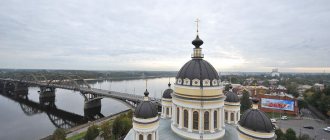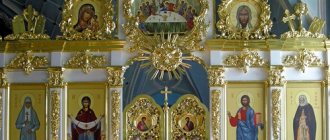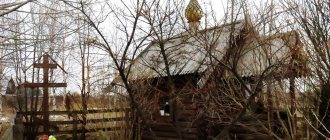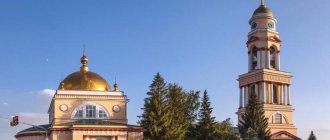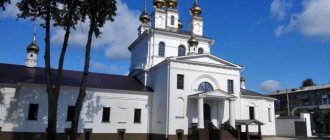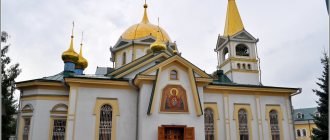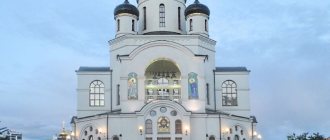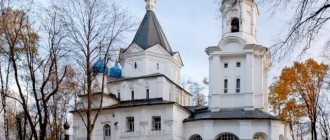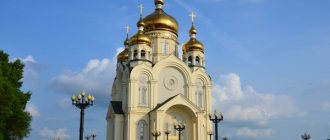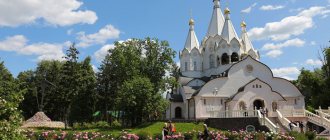Mir
Russia Samara Region Samara Cathedral of the Intercession (Samara) Map loading in progress...
{"format":"leaflet","minzoom":false,"maxzoom":false,"limit":50,"offset":0,"link":"all","sort":[""], "order":[],"headers":"show","mainlabel":"","intro":"","outro":"","searchlabel":"\u2026 \u0441\u043b\u0435\ u0434\u0443\u044e\u0449\u0438\u0435 \u0440\u0435\u0437\u0443\u043b\u044c\u0442\u0430\u0442\u044b","default":"","import-annotation":false,"width ":"auto","height":"350px","centre":{"text":"","title":"""link":"","lat":53.18612999999999857436705497093498706817626953125,"lon": 50.10776700000000261070454143919050693511962890625,"icon":""},"title":"","label":"","icon":"","lines":[],"polygons":[],"circles":[ ],"rectangles":[],"copycoords":false,"static":false,"zoom":8,"defzoom":14,"layers":["OpenStreetMap"],"image layers":[] ,"overlays":[],"resizable":false,"fullscreen":true,"scrollwheelzoom":true,"cluster":false,"clustermaxzoom":9,"clusterzoomonclick":true,"clustermaxradius":80, "clusterspiderfy":true,"geojson":"","clicktarget":"","showtitle":true,"hidenamespace":false,"template":"","userparam":"","activeicon": "","pagelabel":false,"ajaxcoordproperty":"","ajaxquery":"","locations":[{"text":"\u003Cb\u003E\u003Ca href=\"/palomnik/%D0% 9A%D0%B0%D1%84%D0%B5%D0%B4%D1%80%D0%B0%D0%BB%D1%8C%D0%BD%D1%8B%D0%B9_%D0%9F% D0%BE%D0%BA%D1%80%D0%BE%D0%B2%D1%81%D0%BA%D0%B8%D0%B9_%D1%81%D0%BE%D0%B1%D0% BE%D1%80_(%D0%A1%D0%B0%D0%BC%D0%B0%D1%80%D0%B0)\» title=\»\u041a\u0430\u0444\u0435\u0434\u0440\ u0430\u043b\u044c\u043d\u044b\u0439 \u041f\u043e\u043a\u0440\u043e\u0432\u0441\u043a\u0438\u0439 \u0441\u043e\u0431\u043e\u0 440 (\u0421\u0430\u043c\u0430 \u0440\u0430)\»\u003E\u041a\u0430\u0444\u0435\u0434\u0440\u0430\u043b\u044c\u043d\u044b\u0439 \u041f\u043e\u043a\u0440\u043 e\u0432\u0441\u043a\ u0438\u0439 \u0441\u043e\u0431\u043e\u0440 (\u0421\u0430\u043c\u0430\u0440\u0430)\u003C/a\u003E\u003C/b\u003E","title":"\u041a\u04 30 \u0444\u0435\u0434\u0440\u0430\u043b\u044c\u043d\u044b\u0439 \u041f\u043e\u043a\u0440\u043e\u0432\u0441\u043a\u0438\u0439 \ u0441\u043e\u0431\u043e\u0440 (\u0421\u0430\u043c\u0430\u0440\u0430)","link":"","lat":53.18612999999999857436705497093498706817626953125,"lon":50.10776700000000261 070454143919050693511962890625,"icon":""}],"imageLayers":[] }
53.186134; 50.107739
Russia, Samara, Leninskaya street, 75A
Samara, Samara region 443020
Russia
Telephone.:
,.
The Intercession Cathedral is located in the center of Samara at the intersection of Nekrasovskaya and Leninskaya streets (formerly Sokolnichya and then Shikhobalovskaya streets).
About the city
Samara is the economic, historical and cultural center of the Middle Volga region, which is on the territory of the Russian Federation.
The population is 1.2 million people, which allows it to be among the top ten millionaire cities in the country.
The territory of Samara is located on the banks of the Saratov reservoir, near the Samara and Sok rivers.
In addition to many industrial, historical and cultural sites, you can also see excellent examples of religious architecture.
The Intercession Cathedral is one of these (address: Samara, Leninskaya Street, 75A).
Its history is extraordinary; the architecture of the modern stone building amazes with its grandeur and beauty. And the energy of the place itself is so bright and pure that many pilgrims from different cities of Russia and other countries come to the temple’s shrines to pray on religious holidays or for urgent personal needs.
Description
Intercession Cathedral (Samara) is geographically located in the central part of the city. When two hundred years ago there was still a small church in this place, this area was considered a suburb.
As often happens, the city began to grow rapidly (both in terms of houses and in terms of residents), and the construction of new residential buildings began to take place in this location. Therefore, its center moved to this area.
With the generous monetary donations of some parishioners of the old small church, a modern church building was built. The inside was richly decorated, painted, an iconostasis was made, and good temple utensils were purchased.
The cathedral has always (and now also) been famous for its good choir, in which eminent artists sang at one time.
Services are held regularly (the schedule of services in the Intercession Cathedral of Samara will also be outlined in this article later), and therefore there is an opportunity to join the sacraments of communion, confession, baptism, and wedding.
Description with photo
The first acquaintance takes place at the gates of the monastery, through which you can enter the courtyard of the temple complex. You can see what they look like in the photo below.
As you get closer to the main building, you can admire the magnificent architecture of the historical structure. All its splendor is demonstrated in the photo below.
In another photo of the Intercession Cathedral in Samara presented to your attention, you can see how attractive it looks in the winter season.
Story
According to historical information, the Church of the Intercession of the Mother of God was built in 1861. It was the merchants Shikhobalovs who were the parishioners who almost completely financed the construction - they donated about 34 thousand rubles (and therefore all the work was completed after 2 years). It was with these funds that the walls were built and the main decoration of the interior was completed.
The history of the Intercession Cathedral (Samara) says that Saint John of Kronstadt himself was present at the foundation of the monastery.
After all the main work was completed, Bishop Theophilus consecrated the main chapel of the temple - the Intercession of the Most Holy Theotokos, and then the right one - in the name of Mitrofan of Voronezh.
At the beginning of the 20th century, an additional symmetrical extension was built to accommodate the office and sacristy, and a choir was built (in the central part).
Temple of the Virgin Mary
I give you a new commandment, that you love one another; just as I have loved you, let you also love one another. By this everyone will know that you are My disciples, if you have love for one another. (John 13:34-35)
What does it mean to be a Christian, why should they be and in general to be one or not to be? The main thing for a Christian is faith. It is this, being the hidden moment of the inner life of the human person, that determines our attitude to the reality of God’s existence. It is faith that the Savior named as a necessary condition for a person’s participation in eternal life. “Whoever believes and is baptized will be saved; and whoever does not believe will be condemned” (Mark 16:16).
Early Christian theology gave world philosophy an understanding of the individual as a freely thinking, feeling and acting subject of existence. A person himself is free to make a choice between faith and unbelief. However, as the 3rd century Christian writer Tertullian said, “the soul is by nature Christian.” This is the greatest proof of the truth of God’s existence: the Lord reveals himself in an invisible and secret way to the human soul at certain moments of its life.
But faith is not the only condition of Christian life, for it, according to the words of the Apostle John, “without works is dead” (James 2:26). A Christian is called to the feat of active love. Our Lord Jesus Christ defines the commandment of love as the basic and most important: “Thou shalt love the Lord thy God with all thy heart, and with all thy soul, and with all thy mind: this is the first and greatest commandment; the second is similar to it: love your neighbor as yourself; on these two commandments hang all the law and the prophets” (Matthew 22:37-40). The Apostle John the Theologian says that Christian love cannot be something abstract, not associated with concrete deeds of mercy towards one’s neighbor: “Whoever says: “I love God,” but hates his brother, is a liar: for he who does not love his brother Whom he sees, how can he love God Whom he does not see? And we have this commandment from Him, that whoever loves God should also love his brother” (1 John 4:20-21).
Christians, in order to overcome the passions and vices that tear the soul away from communion with God and give rise to selfishness, follow the rules of asceticism - fasting, work and prayer. The Orthodox Church has four long fasts: Great, Nativity, Assumption and Peter and Paul; In addition, Wednesday and Friday of each week are fast days - in memory of the betrayal of the Savior and His death on the Cross.
Different stages of history show different forms of manifestation of Christian feat: the martyrs of the first three centuries of our era, saints and confessors who defended the purity of Orthodox doctrine in the era of the Ecumenical Councils, the reverend elders, the righteous and blessed of the Middle Ages, the new martyrs and confessors of the past century. At all times there is one ideal: “You are the salt of the earth... You are the light of the world... So let your light shine before people, so that they may see your good deeds and glorify your Father in Heaven” (Matthew 5:13-16).
What should a modern Christian be like, what does our Savior want us to be? According to the thoughts of the holy fathers of recent centuries, the essence of the Christian feat of our time is to preserve the peace of Christ in one’s soul, to bring the light of Divine truth to those around us in everyday life. It is unlikely that the greatness of this service will fade against the background of the asceticism of past centuries.
For our people, the Orthodox faith is not only personally acquired, but also bequeathed by many generations of ancestors. We need to “wake up”, come to our senses, “come to our senses”. We need to realize that our state has never existed and will never exist without Orthodoxy.
War and post-war period
Under the bishop of the Kuibyshev diocese Andrei Komarov, the temple became a cathedral (40s of the last century), which it remains to this day.
During the war period, also with donations from parishioners, a column was built in honor of Dmitry Donskoy.
At this time, religious chants are performed in the monastery choir by artists from Moscow theaters who were evacuated to Kuibyshev. These are such celebrities as: Mikhailov M.D., Kozlovsky I.S. and others.
It is also known that during the war and post-war period the following famous archpastors served and performed sacred services in the church: Ioann Snychev, Mitrofan Gutovsky, Manuil Lemeshevsky.
History of the temple
The Intercession Cathedral is located in the center of Samara at the intersection of Nekrasovskaya and Leninskaya streets (formerly Sokolnichya and then Shikhobalovskaya streets). At the beginning of the 19th century, the area of the Intercession Cathedral was located far from the city, and in 1805 a city cemetery was opened here. At the cemetery there was a wooden church in the name of St. John the Baptist with a chapel in the name of the Exaltation of the Cross of the Lord. As urban construction progressed, residential areas moved closer to the cemetery, the number of parishioners increased, and the church was dilapidated and cramped and did not meet the needs of the parishioners.
On the initiative of the Shikhobalov merchants - Anton, Emelyan and Matvey - residents of the neighborhoods adjacent to the church in 1853 turned to the Bishop of Samara - His Eminence Eusebius (Orlinsky) - with a petition for permission to build (instead of a wooden church) a new, more spacious stone church using voluntary donations.
The petition was respected, and His Grace Eusebius, with the permission of the governor, sent a church project to St. Petersburg in 1854, developed by the provincial architect A.I. Meisner. This project was not approved; instead, in 1857, a project by St. Petersburg architect E.I. was sent. Zhibera. During the approval of the project, the cemetery Church of the Baptist was given the status of a parish church, and the cemetery was closed in 1857.
Anton and Emelyan Shikhobalov donated 34,000 rubles for the construction of the temple, which covered the costs of masonry and basic interior decoration. Preparatory work for the construction of the temple began at the end of July 1857, and on September 14, 1857, Bishop Theophilus (Nadezhdin) solemnly laid the foundation stone for the temple. The holy righteous John of Kronstadt participated in the laying of the first stone chapel of the temple.
To manage the construction of the new church, a construction committee was formed, which included brothers Emelyan and Anton Shikhobalov, priests John Slovokhotov and Alexander Tsaregradsky, parish trustees A.P. Parshensky and A.I. Fog. Anton Nikolaevich Shikhobalov was the treasurer of this committee, and subsequently the first church warden of the Intercession Church (from 1858 to 1904).
The construction committee very conscientiously and diligently carried out the construction of the church, which was mainly built in two years. At the request of the Samara Spiritual Consistory, the Holy Synod awarded the Shikhobalov brothers with gold medals, and Parshensky with the Order of St. Stanislav, 3rd degree, for their diligence in the construction of the Church of the Intercession. In addition, benefactors received the right to be buried next to the temple.
The Shikhobalovs built a family crypt within the fence of the church. The burials of the Parshenskys were also located here.
On July 17, 1861, the Right Reverend Theophilus consecrated the main altar in the name of the Intercession of the Most Holy Theotokos, and on November 12, 1861, the right altar was consecrated in the name of St. Mitrofan, the Voronezh miracle worker.
The first rector of the Intercession Church was Archpriest Alexander Tsaregradsky, who served in the church for more than 20 years. After the death of Fr. Alexander's rector was his brother, Archpriest Nikolai Tsaregradsky.
Although according to the project the Church of the Intercession was planned as a three-altar church, for a long time the sacristy and office with the church archive were located in the left aisle. In 1906-1907, at the expense of the merchant Pyotr Ivanovich Shikhobalov, a symmetrical extension was made on the western side of the temple, where the office and sacristy were moved, and a choir was built above the western entrance.
In 1911, for the left side chapel, church warden P.I. Shikhobalov purchased gilded metal vestments in Moscow from Meshkov’s company, and all the necessary utensils were also delivered from Moscow. On August 19, 1911, Bishop Konstantin (Bulychev) consecrated the left altar in honor of St. Martyr Emilian.
The architecture of the Intercession Church is made in the style of Moscow temple architecture of the 17th century. The temple has a traditional Russian five-domed structure with a hipped bell tower above the entrance and can accommodate up to 2000 people. Archival documents from the beginning of the 20th century describe that the outer walls of the temple were decorated with paintings, and the temple was covered with white English tin. The interior decoration of the temple was very rich. The altars were lined with artificial marble (in 1876), the walls were covered with frescoes painted by artists Krivolutsky and Knyazev (1909-1910). The painting of the Church of the Intercession was originally Fryazh (from “Fryazin” - Italian), which began to take shape in Russia in the second half of the 17th century under the influence of Western European artists. Since the 18th century, after the establishment of the Academy of Arts, this style has been called academic, differing from traditional icon painting in the realism of the image.
The icons were mostly of new writing; among the shrines of the temple, the icon of the Holy Image of Jesus Christ in a silver-plated copper robe, painted in 1662, and the cross made of gilded silver with the relics of the holy saints of God, donated to the temple in 1869 by the merchant Dmitry Ivanovich, were especially revered. Podsosov. The Church of the Intercession, as reported by the Samara Diocesan Gazette in 1911, was considered “one of the best Samara churches in terms of its decoration.”
For 60 years, the Intercession Church received generous donations from the Shikhobalov merchants. They paid for the reconstruction and repair of the building, interior decoration, production and installation of iconostases, and purchased expensive utensils and vestments for clergy. In particular, Anton Nikolaevich Shikhobalov replaced the silent large bell with a new one weighing 257 pounds, paid for lining the inside of the church with artificial marble, built a house for the church clergy, opened a Sunday school for adults, and in 1890, with his funds, a cemetery was built near the church on the site of a former cemetery Pokrovsky Square with a fence. At the same time, Anton Nikolaevich did not like to talk about the true size of the help, since he did not tolerate the ostentatious side of charity. His simplicity and sincerity were amazing: “There is money, we need to build,” he said. An honorary citizen of Samara, Anton Nikolaevich died quietly on his birthday in 1908, when he turned 81 years old.
After the revolution of 1917, a split occurred in the Orthodox Church associated with the emergence of the “renovationism” heresy, actively supported by the new Bolshevik government. In the Samara diocese, the position of the renovationists turned out to be quite strong; they captured a number of churches, including the Church of the Intercession, which in 1930 was made the cathedral church of the renovationist Middle Volga Metropolis. In the 20-30s, as a result of repressions committed by the authorities against the Orthodox Church and its ministers in Samara, out of 55 Orthodox churches, 54 churches were closed, destroyed or vandalized. In the period from 1938 to 1946, there was only one functioning church in the city - Pokrovskaya. In 1938, after the arrest of the renovationist false metropolitan Vasily, the renovationist parish of the Intercession Church dispersed, and after some time the temple reunited with the Moscow Patriarchate.
In September 1941, Archbishop Andrei (Komarov) was appointed ruling bishop of the Kuibyshev diocese, who had previously worked hard to restore the authority of the Orthodox Church in Kuibyshev, which had been destroyed by the renovationists. The Church of the Intercession becomes the cathedral of the Kuibyshev (now Samara) diocese and remains so to this day.
During the Great Patriotic War, the Intercession Cathedral constantly participated in collecting donations for various wartime funds, including funds for a tank column named after Dmitry Donskoy.
As a cathedral, the Intercession Cathedral was distinguished by the solemnity of its services and a magnificent choir. The traditions of church singing are associated with the time of the Great Patriotic War, when the choirs in the Kuibyshev churches were the best in Russia, since the artists of the capital's theaters evacuated to Kuibyshev, including the Bolshoi Theater, sang in them: I.S. Kozlovsky, M.D. Mikhailov and other wonderful singers. The choir director was composer L.F. Drugov. The singing school has survived to this day, as can be seen at the annual Christmas and Easter concerts at the Opera and Ballet Theater, which stands on the site of the former cathedral - Spaso-Resurrection Cathedral, the idea of restoring which is not abandoned by Samara residents.
During the war and post-war years, bishops' services were performed in the Intercession Cathedral by famous archpastors who ruled the Kuibyshev diocese and who worked worthily in the field of spiritual revival and establishment of Orthodoxy: Archbishop Alexy (Palitsyn), Bishop Mitrofan (Gutovsky), who now rest in the crypt of the narthex of the Intercession Cathedral, Metropolitan Manuel (Lemeshevsky), whose tomb is located in the vestibule of the cathedral, Metropolitan John (Snychev).
Fire
At the end of the 70s of the last century, due to an absurd accident (according to some reports, due to a sparkler falling into the window opening of the temple), a fire occurred in the Intercession Cathedral (Samara).
As a result of this incident, the nun who was on duty that day at the monastery died, and wall paintings and some shrines were burned.
The temple took about four years to restore. The new painting has already been done by Western Ukrainian masters of the 20th century.
And in the 90s, tent coverings were decorated with gilded paint.
Architecture Features
Experts in the field of construction and design claim that the Intercession Cathedral in Samara was built in the style of Moscow temple architecture, which was popular in the 17th century.
The monastery has 5 domes and a hipped bell tower above the entrance. Initially, its outer walls were decorated with paintings - against a background of white English tin.
The most well-known fact about the interior design is that at the end of the 19th century the altars were decorated with artificial marble, which was more expensive than natural marble.
The walls were also decorated with frescoes, including frescoes (Italian style). This was a new trend that came to Russia from Europe. The main feature of this painting is its academic design (as opposed to the traditional, more fantastical one).
At the beginning of the last century, the temple was one of the best in Samara both in terms of design, luxurious interior decoration, and in terms of holding services.
History[edit]
At the beginning of the 19th century, the area of the Intercession Cathedral was located far from the city, and in 1805 a city cemetery was opened here. At the cemetery there was a wooden church in the name of St. John the Baptist with a chapel in the name of the Exaltation of the Cross of the Lord. As urban construction progressed, residential areas moved closer to the cemetery, the number of parishioners increased, and the church was dilapidated and cramped and did not meet the needs of the parishioners.
On the initiative of the Shikhobalov merchants - Anton, Emelyan and Matvey - residents of the neighborhoods adjacent to the church in 1853 turned to the Bishop of Samara - His Eminence Eusebius (Orlinsky) - with a petition for permission to build (instead of a wooden church) a new, more spacious stone church using voluntary donations.
The petition was respected, and His Grace Eusebius, with the permission of the governor, sent a church project to St. Petersburg in 1854, developed by the provincial architect A.I. Meisner. This project was not approved; instead, in 1857, a project by St. Petersburg architect E.I. was sent. Zhibera. During the approval of the project, the cemetery Church of the Baptist was given the status of a parish church, and the cemetery was closed in 1857.
Anton and Emelyan Shikhobalov donated 34,000 rubles for the construction of the temple, which covered the costs of masonry and basic interior decoration. Preparatory work for the construction of the temple began at the end of July 1857, and on September 14, 1857, Bishop Theophilus (Nadezhdin) solemnly laid the foundation stone for the temple. The holy righteous John of Kronstadt participated in the laying of the first stone chapel of the temple.
To manage the construction of the new church, a construction committee was formed, which included brothers Emelyan and Anton Shikhobalov, priests John Slovokhotov and Alexander Tsaregradsky, parish trustees A.P. Parshensky and A.I. Fog. Anton Nikolaevich Shikhobalov was the treasurer of this committee, and subsequently the first church warden of the Intercession Church (from 1858 to 1904).
The construction committee very conscientiously and diligently carried out the construction of the church, which was mainly built in two years. At the request of the Samara Spiritual Consistory, the Holy Synod awarded the Shikhobalov brothers with gold medals, and Parshensky with the Order of St. Stanislav, 3rd degree, for their diligence in the construction of the Church of the Intercession. In addition, benefactors received the right to be buried next to the temple.
The Shikhobalovs built a family crypt within the fence of the church. The burials of the Parshenskys were also located here.
On July 17, 1861, the Right Reverend Theophilus consecrated the main altar in the name of the Intercession of the Most Holy Theotokos, and on November 12, 1861, the right altar was consecrated in the name of St. Mitrofan, the Voronezh miracle worker.
The first rector of the Intercession Church was Archpriest Alexander Tsaregradsky, who served in the church for more than 20 years. After the death of Fr. Alexander's rector was his brother, Archpriest Nikolai Tsaregradsky.
Although according to the project the Church of the Intercession was planned as a three-altar church, for a long time the sacristy and office with the church archive were located in the left aisle. In 1906-1907, at the expense of the merchant Pyotr Ivanovich Shikhobalov, a symmetrical extension was made on the western side of the temple, where the office and sacristy were moved, and a choir was built above the western entrance.
In 1911, for the left side chapel, church warden P.I. Shikhobalov purchased gilded metal vestments in Moscow from Meshkov’s company, and all the necessary utensils were also delivered from Moscow. On August 19, 1911, Bishop Konstantin (Bulychev) consecrated the left altar in honor of St. Martyr Emilian.
The architecture of the Intercession Church is made in the style of Moscow temple architecture of the 17th century. The temple has a traditional Russian five-domed structure with a hipped bell tower above the entrance and can accommodate up to 2000 people. Archival documents from the beginning of the 20th century describe that the outer walls of the temple were decorated with paintings, and the temple was covered with white English tin. The interior decoration of the temple was very rich. The altars were lined with artificial marble (in 1876), the walls were covered with frescoes painted by artists Krivolutsky and Knyazev (1909-1910). The painting of the Church of the Intercession was originally Fryazh (from “Fryazin” - Italian), which began to take shape in Russia in the second half of the 17th century under the influence of Western European artists. Since the 18th century, after the establishment of the Academy of Arts, this style has been called academic, differing from traditional icon painting in the realism of the image.
The icons were mostly of new writing; among the shrines of the temple, the icon of the Holy Image of Jesus Christ in a silver-plated copper robe, painted in 1662, and the cross made of gilded silver with the relics of the holy saints of God, donated to the temple in 1869 by the merchant Dmitry Ivanovich, were especially revered. Podsosov. The Church of the Intercession, as reported by the Samara Diocesan Gazette in 1911, was considered “one of the best Samara churches in terms of its decoration.”
For 60 years, the Intercession Church received generous donations from the Shikhobalov merchants. They paid for the reconstruction and repair of the building, interior decoration, production and installation of iconostases, and purchased expensive utensils and vestments for clergy. In particular, Anton Nikolaevich Shikhobalov replaced the silent large bell with a new one weighing 257 pounds, paid for lining the inside of the church with artificial marble, built a house for the church clergy, opened a Sunday school for adults, and in 1890, with his funds, a cemetery was built near the church on the site of a former cemetery Pokrovsky Square with a fence. At the same time, Anton Nikolaevich did not like to talk about the true size of the help, since he did not tolerate the ostentatious side of charity. His simplicity and sincerity were amazing: “There is money, we need to build,” he said. An honorary citizen of Samara, Anton Nikolaevich died quietly on his birthday in 1908, when he turned 81 years old.
After the revolution of 1917, a split occurred in the Orthodox Church associated with the emergence of the “renovationism” heresy, actively supported by the new Bolshevik government. In the Samara diocese, the position of the renovationists turned out to be quite strong; they captured a number of churches, including the Church of the Intercession, which in 1930 was made the cathedral church of the renovationist Middle Volga Metropolis. In the 20-30s, as a result of repressions committed by the authorities against the Orthodox Church and its ministers in Samara, out of 55 Orthodox churches, 54 churches were closed, destroyed or vandalized. In the period from 1938 to 1946, there was only one functioning church in the city - Pokrovskaya. In 1938, after the arrest of the renovationist false metropolitan Vasily, the renovationist parish of the Intercession Church dispersed, and after some time the temple reunited with the Moscow Patriarchate.
In September 1941, Archbishop Andrei (Komarov) was appointed ruling bishop of the Kuibyshev diocese, who had previously worked hard to restore the authority of the Orthodox Church in Kuibyshev, which had been destroyed by the renovationists. The Church of the Intercession becomes the cathedral of the Kuibyshev (now Samara) diocese and remains so to this day.
During the Great Patriotic War, the Intercession Cathedral constantly participated in collecting donations for various wartime funds, including funds for a tank column named after Dmitry Donskoy.
As a cathedral, the Intercession Cathedral was distinguished by the solemnity of its services and a magnificent choir. The traditions of church singing are associated with the time of the Great Patriotic War, when the choirs in the Kuibyshev churches were the best in Russia, since the artists of the capital's theaters evacuated to Kuibyshev, including the Bolshoi Theater, sang in them: I.S. Kozlovsky, M.D. Mikhailov and other wonderful singers. The choir director was composer L.F. Drugov. The singing school has survived to this day, as can be seen at the annual Christmas and Easter concerts at the Opera and Ballet Theater, which stands on the site of the former cathedral - Spaso-Resurrection Cathedral, the idea of restoring which is not abandoned by Samara residents.
During the war and post-war years, bishops' services were performed in the Intercession Cathedral by famous archpastors who ruled the Kuibyshev diocese and who worked worthily in the field of spiritual revival and establishment of Orthodoxy: Archbishop Alexy (Palitsyn), Bishop Mitrofan (Gutovsky), who now rest in the crypt of the narthex of the Intercession Cathedral, Metropolitan Manuel (Lemeshevsky), whose tomb is located in the vestibule of the cathedral, Metropolitan John (Snychev).
Special events in the history of the cathedral include the following: the funeral of Bishop Manuel in 1968; the presence in May 1997 of the miraculous icon of St. Nicholas, Archbishop of Myra in Lycia, consecrated on the relics of the saint in the city of Bari (Italy); divine services for the Feast of the Intercession of the Mother of God on October 13 and 14, 1999, which were performed by His Holiness Patriarch Alexy II of Moscow and All Rus', concelebrated by Archbishop Sergius of Samara and Syzran, and the service of the Divine Liturgy on May 13, 2001 by His Beatitude Vladimir, Metropolitan of Kyiv and All Ukraine, during his visit to Samara land.
There is also a tragic page in the history of the Intercession Cathedral. On November 7, 1977, during a demonstration in honor of the 60th anniversary of the October Revolution, someone threw a sparkler (according to other sources, a Molotov cocktail) through the window of the Intercession Cathedral. It was a day off, and only nun Maria (Mandrykina) was in the church. The fire ignited the varnish covering the wall painting. Mother Maria managed to call the firefighters, but before they arrived she suffocated in the smoke. The fire almost completely destroyed the painting of the last century; only the domed icon of the Intercession of the Virgin Mary survived. The icons “Seeking the Lost,” St. Nicholas of Mozhaisk, St. Blessed Prince Alexander Nevsky and “Praise of the Most Holy Theotokos.” The fire reached the tomb of Metropolitan Manuel in the vestibule and stopped. The restoration of the temple lasted almost four years. New murals were made by local artists and painters from Western Ukraine.
At the end of 1991, during excavation work along the collector route, the vault of the family crypt of the Shikhobalov merchants was opened. By order of Archbishop Eusebius (Savvin), part of the remains (as far as the excavation allowed) was removed, placed in a new coffin and buried on Radonitsa 1992 on the territory of the cathedral, on the left side (near the baptismal sanctuary), and the burial order was fully completed.
In 1996, the cathedral's tent coverings were decorated with the latest gold-effect coating.
Temple shrines
The Intercession Cathedral in Samara stores under its arches great spiritual treasures, to which believers rush to venerate on holidays and ordinary (everyday) days.
Here are some of them:
- a particle of the Life-giving Cross of the Lord;
- stone of the Life-Giving Sepulcher of the Lord;
- the image of St. Mitrofan - the Voronezh wonderworker (and a particle of the relics of the saint);
- an ark with a particle of the relics of St. Nicholas the Wonderworker of Myra;
- particles of the relics of various saints, including the Holy Blessed Grand Duke Alexander Nevsky, Saint Basil of Antioch and others;
- miraculous icons of the Queen of Heaven - “Softening Evil Hearts”, “Seeking the Lost”, Tabynskaya.
Shrines[edit]
The icon “Softening Evil Hearts”, or “Simeon’s Prophecy”, is associated with the event of the Presentation of the Lord (February 2 according to the old style, or February 15 according to the new style) - the bringing of the infant Christ to the Jerusalem temple on the fortieth day. It symbolizes the fulfillment of the prophecy of the righteous elder Simeon the God-Receiver of the Mother of God: “A weapon will pierce your soul.” In the icon, the Mother of God is depicted with seven swords stuck in her heart - three on the right and left, one on the bottom. The number “7” in the Holy Scripture means the fullness of something, in this case - the fullness of that grief, sadness and heart disease that was in the life of the Blessed Virgin Mary on earth. Before the icon of the Long-Suffering Mother of God, they pray for the relief of mental and physical suffering, for the softening of hostile relationships, for the softening of their hearts and the hearts of their loved ones and enemies, and in general for the depletion of evil in the world.
The Tabyn Icon is a copy of the Kazan Icon of the Mother of God, and is named after the place where it was found on a large stone at the foot of the mountain above the “Holy Keys” spring near the village of Tabynskoye, Sterlitamak district, Ufa province. This happened twice - in the 16th and 18th centuries. The first time the icon appeared to the hierodeacon of a nearby monastery, and the second time the Bashkirs found it and abused it, for which they became blind. This icon, like the icon of the Most Holy Theotokos “Seeking the Lost,” is distinguished by a very dark Face, as if symbolizing “the darkness of our sins.” And we pray before this icon to enlighten us, softening “our hardened hearts with the dew of the prayers” of the Mother of God.
In the vestibule of the church, the first cross from the grave of Metropolitan of St. Petersburg and Ladoga John (Snychev) (1927-1995), who was a student of Metropolitan Manuel and his cell attendant, and from 1965 to 1990 - the most beloved Samara archpastor, was recently installed and venerated. A prayer book, a spiritual writer, the creator of the modern ideology of Russian national revival, an elder-bishop, at the same time a simple and approachable person (he accepted anyone until 11 pm - the time of the cell rule). His sincerity and love (he even punished with love) evoked reciprocal feelings of recognition and love. Bishop John died on November 2, 1995 and was buried at the Nikolskoye cemetery of the Alexander Nevsky Lavra in St. Petersburg.
Miracles and special events in the life of the monastery
The icons of the Blessed Virgin Mary performed (as stated in the historical chronicles of the temple for the years 1862-1900) many miracles:
- healing from obsession;
- insight for the blind;
- development of hearing in the hearing impaired;
- help with droughts and lack of productivity, invasion of harmful insects, and so on.
The main condition under which help came was to sincerely and with faith and gratitude pray for help to the Queen of Heaven. Which is what the parishioners of that time did.
Before the icon “Seeking the Lost” in the church, hymns and prayers are regularly performed (on Tuesdays), and on special days religious processions are carried out with it.
The icon “Softening Evil Hearts” is especially loved by parishioners, in front of which they also make sincere prayers - to soften tense relationships (especially in families), hearts and souls, to alleviate mental and physical ailments, to reduce evil throughout the world, and so on.
The Tabyn Icon is also held in special esteem by Samarans. She is distinguished by a dark face, and her image is similar to that depicted on the Kazan Icon of the Mother of God. Before her they usually pray for deliverance from sins, for the acquisition of purity and enlightenment.
Another relic of the monastery is the first cross from the burial place of Metropolitan of Ladoga and St. Petersburg Ioann Snychev. Since the mid-60s of the last century, he was a well-known and beloved archpastor at the Church of the Intercession (a student of Metropolitan Manuel). By nature, he was a kind, open and simple person who always received parishioners, prayed with them, and gave the right advice. He is also known as a spiritual writer, the founder of the ideology of Russian national revival.
But the most revered by local residents are Metropolitans Manuel and John. It is their spiritual heritage that greatly helps Orthodox believers in solving vital issues of today. These were a teacher and a student who worked sincerely and for quite a long time in the name of the Lord: they equipped the cathedral, held services, and created spiritual and educational works.
Also, the Intercession Cathedral in Samara experienced some special events during its existence:
- carrying out Bishop Manuel on his final journey (1968);
- the presence of the image of St. Nicholas from Myra Lycia (May 1997), who performed many great miracles of healing (was consecrated over the relics of the saint in Italy - the city of Bari);
- divine service by Patriarch Alexy II of Moscow on the great feast of the Intercession (October 1999);
- serving the liturgy by Patriarch Vladimir of Kyiv and All Ukraine when he was in Samara (2001).
Temple Cathedral in honor of the Intercession of the Mother of God
Address: Samara, 443020, st. Leninskaya, 75-A. Contact phone: 333-41-29, 333-25-15
Three-dimensional panoramas https://palomnik63.ru/panoramas/411_pokrova_presvyatoy_bogoroditsy_samara/
Website: https://https://samara-pokrov.cerkov.ru
Rector: Archpriest Pavel Ivanovich Goncharov
Deanery: Samara Starogorodskoe
Additional information: The Intercession Cathedral is located in the center of Samara at the intersection of Nekrasovskaya and Leninskaya streets (formerly Sokolnichiya and then Shikhobalovskaya streets). At the beginning of the 19th century, the area of the Intercession Cathedral was located far from the city, and in 1805 a city cemetery was opened here. At the cemetery there was a wooden church in the name of St. John the Baptist with a chapel in the name of the Exaltation of the Cross of the Lord. As urban construction progressed, residential areas moved closer to the cemetery, the number of parishioners increased, and the church was dilapidated and cramped and did not meet the needs of the parishioners.
On the initiative of the Shikhobalov merchants - Anton, Emelyan and Matvey - residents of the neighborhoods adjacent to the church in 1853 turned to the Bishop of Samara - His Eminence Eusebius (Orlinsky) - with a petition for permission to build (instead of a wooden church) a new, more spacious stone church using voluntary donations.
The petition was respected, and His Grace Eusebius, with the permission of the governor, sent a church project to St. Petersburg in 1854, developed by the provincial architect A.I. Meisner. This project was not approved; instead, in 1857, a project by St. Petersburg architect E.I. was sent. Zhibera. During the approval of the project, the cemetery Church of the Baptist was given the status of a parish church, and the cemetery was closed in 1857.
Anton and Emelyan Shikhobalov donated 34,000 rubles for the construction of the temple, which covered the costs of masonry and basic interior decoration. Preparatory work for the construction of the temple began at the end of July 1857, and on September 14, 1857, Bishop Theophilus (Nadezhdin) solemnly laid the foundation stone for the temple. The holy righteous John of Kronstadt participated in the laying of the first stone chapel of the temple.
To manage the construction of the new church, a construction committee was formed, which included brothers Emelyan and Anton Shikhobalov, priests John Slovokhotov and Alexander Tsaregradsky, parish trustees A.P. Parshensky and A.I. Fog. Anton Nikolaevich Shikhobalov was the treasurer of this committee, and subsequently the first church warden of the Intercession Church (from 1858 to 1904).
The construction committee very conscientiously and diligently carried out the construction of the church, which was mainly built in two years. At the request of the Samara Spiritual Consistory, the Holy Synod awarded the Shikhobalov brothers with gold medals, and Parshensky with the Order of St. Stanislav, 3rd degree, for their diligence in the construction of the Church of the Intercession. In addition, benefactors received the right to be buried next to the temple.
The Shikhobalovs built a family crypt within the fence of the church. The burials of the Parshenskys were also located here.
On July 17, 1861, the Right Reverend Theophilus consecrated the main altar in the name of the Intercession of the Most Holy Theotokos, and on November 12, 1861, the right altar was consecrated in the name of St. Mitrofan, the Voronezh miracle worker.
The first rector of the Intercession Church was Archpriest Alexander Tsaregradsky, who served in the church for more than 20 years. After the death of Fr. Alexander's rector was his brother, Archpriest Nikolai Tsaregradsky.
Although according to the project the Church of the Intercession was planned as a three-altar church, for a long time the sacristy and office with the church archive were located in the left aisle. In 1906-1907, at the expense of the merchant Pyotr Ivanovich Shikhobalov, a symmetrical extension was made on the western side of the temple, where the office and sacristy were moved, and a choir was built above the western entrance.
In 1911, for the left side chapel, church warden P.I. Shikhobalov purchased gilded metal vestments in Moscow from Meshkov’s company, and all the necessary utensils were also delivered from Moscow. On August 19, 1911, Bishop Konstantin (Bulychev) consecrated the left altar in honor of St. Martyr Emilian.
The architecture of the Intercession Church is made in the style of Moscow temple architecture of the 17th century. The temple has a traditional Russian five-domed structure with a hipped bell tower above the entrance and can accommodate up to 2000 people. Archival documents from the beginning of the 20th century describe that the outer walls of the temple were decorated with paintings, and the temple was covered with white English tin. The interior decoration of the temple was very rich. The altars were lined with artificial marble (in 1876), the walls were covered with frescoes painted by artists Krivolutsky and Knyazev (1909-1910). The painting of the Church of the Intercession was originally Fryazh (from “Fryazin” - Italian), which began to take shape in Russia in the second half of the 17th century under the influence of Western European artists. Since the 18th century, after the establishment of the Academy of Arts, this style has been called academic, differing from traditional icon painting in the realism of the image.
The icons were mostly of new writing; among the shrines of the temple, the icon of the Holy Image of Jesus Christ in a silver-plated copper robe, painted in 1662, and the cross made of gilded silver with the relics of the holy saints of God, donated to the temple in 1869 by the merchant Dmitry Ivanovich, were especially revered. Podsosov. The Church of the Intercession, as reported by the Samara Diocesan Gazette in 1911, was considered “one of the best Samara churches in terms of its decoration.”
For 60 years, the Intercession Church received generous donations from the Shikhobalov merchants. They paid for the reconstruction and repair of the building, interior decoration, production and installation of iconostases, and purchased expensive utensils and vestments for clergy. In particular, Anton Nikolaevich Shikhobalov replaced the silent large bell with a new one weighing 257 pounds, paid for lining the inside of the church with artificial marble, built a house for the church clergy, opened a Sunday school for adults, and in 1890, with his funds, a cemetery was built near the church on the site of a former cemetery Pokrovsky Square with a fence. At the same time, Anton Nikolaevich did not like to talk about the true size of the help, since he did not tolerate the ostentatious side of charity. His simplicity and sincerity were amazing: “There is money, we need to build,” he said. An honorary citizen of Samara, Anton Nikolaevich died quietly on his birthday in 1908, when he turned 81 years old.
After the revolution of 1917, a split occurred in the Orthodox Church associated with the emergence of the “renovationism” heresy, actively supported by the new Bolshevik government. In the Samara diocese, the position of the renovationists turned out to be quite strong; they captured a number of churches, including the Church of the Intercession, which in 1930 was made the cathedral church of the renovationist Middle Volga Metropolis. In the 20-30s, as a result of repressions committed by the authorities against the Orthodox Church and its ministers in Samara, out of 55 Orthodox churches, 54 churches were closed, destroyed or vandalized. In the period from 1938 to 1946, there was only one functioning church in the city - Pokrovskaya. In 1938, after the arrest of the renovationist false metropolitan Vasily, the renovationist parish of the Intercession Church dispersed, and after some time the temple reunited with the Moscow Patriarchate.
In September 1941, Archbishop Andrei (Komarov) was appointed ruling bishop of the Kuibyshev diocese, who had previously worked hard to restore the authority of the Orthodox Church in Kuibyshev, which had been destroyed by the renovationists. The Church of the Intercession becomes the cathedral of the Kuibyshev (now Samara) diocese and remains so to this day.
During the Great Patriotic War, the Intercession Cathedral constantly participated in collecting donations for various wartime funds, including funds for a tank column named after Dmitry Donskoy.
As a cathedral, the Intercession Cathedral was distinguished by the solemnity of its services and a magnificent choir. The traditions of church singing are associated with the time of the Great Patriotic War, when the choirs in the Kuibyshev churches were the best in Russia, since the artists of the capital's theaters evacuated to Kuibyshev, including the Bolshoi Theater, sang in them: I.S. Kozlovsky, M.D. Mikhailov and other wonderful singers. The choir director was composer L.F. Drugov. The singing school has survived to this day, as can be seen at the annual Christmas and Easter concerts at the Opera and Ballet Theater, which stands on the site of the former cathedral - Spaso-Resurrection Cathedral, the idea of restoring which is not abandoned by Samara residents.
During the war and post-war years, bishops' services were performed in the Intercession Cathedral by famous archpastors who ruled the Kuibyshev diocese and who worked worthily in the field of spiritual revival and establishment of Orthodoxy: Archbishop Alexy (Palitsyn), Bishop Mitrofan (Gutovsky), who now rest in the crypt of the narthex of the Intercession Cathedral, Metropolitan Manuel (Lemeshevsky), whose tomb is located in the vestibule of the cathedral, Metropolitan John (Snychev).
Among the shrines of the temple is a Cross with a particle of the tree of the Honest and Life-Giving Cross of the Lord, an icon of St. Mitrofan, the Voronezh wonderworker, with a particle of his relics, a reliquary with the relics of St. Nicholas, Archbishop World of the Lycian Wonderworker, St. Gregory Decapolite, St. Ignatius, bishop Rostovsky, St. martyr Archdeacon Lawrence, St. Vmch. Barbara, St. martyr Basil of Ankyra, St. Ignatius the Great, St. good led book Alexander Nevsky, St. Vmch. and healer Panteleimon, St. Joannicius the Great, St. Sergius of Radonezh, St. Vasily, bishop Amasia, St. Ephraim the Syrian, sschmch. Ignatius the God-Bearer, St. John the Merciful, Patr. Alexandria, St. Arsenia, bishop Tverskoy, St. martyr Samon of Edessa, St. Basil of Antioch. A Part of the Life-Giving Cross of the Lord and a Stone from the Life-Giving Tomb of the Savior are also kept here.
The shrines of the temple include the miraculous image of the Most Holy Theotokos “Seeking the Lost”, as well as the images of the Mother of God “Softening Evil Hearts” and Tabynskaya.
The icon “Softening Evil Hearts”, or “Simeon’s Prophecy”, is associated with the event of the Presentation of the Lord (February 2 according to the old style, or February 15 according to the new style) - the bringing of the infant Christ to the Jerusalem temple on the fortieth day. It symbolizes the fulfillment of the prophecy of the righteous elder Simeon the God-Receiver of the Mother of God: “A weapon will pierce your soul.” In the icon, the Mother of God is depicted with seven swords stuck in her heart - three on the right and left, one on the bottom. The number “7” in the Holy Scripture means the fullness of something, in this case - the fullness of that grief, sadness and heart disease that was in the life of the Blessed Virgin Mary on earth. Before the icon of the Long-Suffering Mother of God, they pray for the relief of mental and physical suffering, for the softening of hostile relationships, for the softening of their hearts and the hearts of their loved ones and enemies, and in general for the depletion of evil in the world.
The Tabyn Icon is a copy of the Kazan Icon of the Mother of God, and is named after the place where it was found on a large stone at the foot of the mountain above the “Holy Keys” spring near the village of Tabynskoye, Sterlitamak district, Ufa province. This happened twice - in the 16th and 18th centuries. The first time the icon appeared to the hierodeacon of a nearby monastery, and the second time the Bashkirs found it and abused it, for which they became blind. This icon, like the icon of the Most Holy Theotokos “Seeking the Lost,” is distinguished by a very dark Face, as if symbolizing “the darkness of our sins.” And we pray before this icon to enlighten us, softening “our hardened hearts with the dew of the prayers” of the Mother of God.
In the vestibule of the church, the first cross from the grave of Metropolitan of St. Petersburg and Ladoga John (Snychev) (1927-1995), who was a student of Metropolitan Manuel and his cell attendant, and from 1965 to 1990 - the most beloved Samara archpastor, was recently installed and venerated. A prayer book, a spiritual writer, the creator of the modern ideology of Russian national revival, an elder-bishop, at the same time a simple and approachable person (he accepted anyone until 11 pm - the time of the cell rule). His sincerity and love (he even punished with love) evoked reciprocal feelings of recognition and love. Bishop John died on November 2, 1995 and was buried at the Nikolskoye cemetery of the Alexander Nevsky Lavra in St. Petersburg.
On the day of his angel, October 9, the St. John’s readings are held annually in Samara, the purpose of which is to comprehend and convey to compatriots the spiritual heritage of Metropolitan John, to consider the spiritual foundations of Russian history and culture, pedagogy and education.
The spiritual heritage of two rulers revered by Samara and St. Petersburg residents, Metropolitans Manuel and John (teacher and student), provide answers to the most complex and painful questions of modernity and eternity and serve as a guiding star to salvation. The publication of their rich spiritual heritage is carried out by the official organ of the Samara diocese - the Orthodox almanac “Spiritual Interlocutor”. “The ascetic activity of my predecessors overshadows our current faith-building,” says Archbishop of Samara and Syzran, His Eminence Sergius about Metropolitans Manuel and John, believing that through their efforts the diocese has preserved a truly Christian Orthodox face.
Vladyka Sergius (Poletkin) was appointed to the Samara See in 1993 on February 25, a significant day for Samara residents, when the memory of St. Alexy, the heavenly patron of the Samara region, and the Iveron Icon of the Mother of God - the Good Goalkeeper, are celebrated, which, as it were, opened the hearts and doors of the Vladyka Samara land. During the eight years of Bishop Sergius’s administration, about 110 churches and 75 Sunday schools were built and opened in the diocese, the Samara Theological Seminary operates, numerous Orthodox publications, radio and television programs are published, the Brotherhood of St. Alexis and spiritual and educational centers operate, and the social movements “Orthodox Samara” are established "and the charitable foundation "Orthodox Togliatti", Christmas and St. John's readings are held. And many more economic, educational and prayer ministries marked the activity of the Bishop on Samara land. Bishop Sergius pays special attention to the seminary, of which he is the rector, as well as to the Intercession Cathedral, being its rector.
Special events in the history of the cathedral include the following: the funeral of Bishop Manuel in 1968; the presence in May 1997 of the miraculous icon of St. Nicholas, Archbishop of Myra in Lycia, consecrated on the relics of the saint in the city of Bari (Italy); divine services for the Feast of the Intercession of the Mother of God on October 13 and 14, 1999, which were performed by His Holiness Patriarch Alexy II of Moscow and All Rus', concelebrated by Archbishop Sergius of Samara and Syzran, and the service of the Divine Liturgy on May 13, 2001 by His Beatitude Vladimir, Metropolitan of Kyiv and All Ukraine, during his visit to Samara land.
There is also a tragic page in the history of the Intercession Cathedral. On November 7, 1977, during a demonstration in honor of the 60th anniversary of the October Revolution, someone threw a sparkler (according to other sources, a Molotov cocktail) through the window of the Intercession Cathedral. It was a day off, and only nun Maria (Mandrykina) was in the church. The fire ignited the varnish covering the wall painting. Mother Maria managed to call the firefighters, but before they arrived she suffocated in the smoke. The fire almost completely destroyed the painting of the last century; only the domed icon of the Intercession of the Virgin Mary survived. The icons “Seeking the Lost,” St. Nicholas of Mozhaisk, St. Blessed Prince Alexander Nevsky and “Praise of the Most Holy Theotokos.” The fire reached the tomb of Metropolitan Manuel in the vestibule and stopped. The restoration of the temple lasted almost four years. New murals were made by local artists and painters from Western Ukraine.
At the end of 1991, during excavation work along the collector route, the vault of the family crypt of the Shikhobalov merchants was opened. By order of Archbishop Eusebius (Savvin), part of the remains (as far as the excavation allowed) was removed, placed in a new coffin and buried on Radonitsa 1992 on the territory of the cathedral, on the left side (near the baptismal sanctuary), and the burial order was fully completed.
In 1996, the cathedral's tent coverings were decorated with the latest gold-effect coating.
Bishop's services are regularly held in the Intercession Cathedral, all necessary sacraments (baptism, wedding, unction, etc.) and services are performed. The clergy of the cathedral actively carry out spiritual and educational work. Sunday school is open for children, classes for adults are held on Tuesdays. At the temple there is a store with a wide selection of icons and Orthodox literature.
Services
Liturgies are regularly celebrated in the Intercession Cathedral (Samara):
- from Monday to Friday – at 8.30;
- on Saturday and Sunday – at 7.00 and 9.30.
You can also hear excellent singing of the Orthodox choir here. The manner, quality and purity of performance were left imprinted in their time (wartime) by the most famous metropolitan artists who stayed in the church - composer and conductor Leonid Dugov, Ivan Kozlovsky and others. It was they who sang church chants in the monastery during the evacuation.
All this did not happen by chance, because the Church of the Intercession has excellent acoustics and a special spiritual atmosphere.
Therefore, anyone has the opportunity not only to attend the sacred liturgy (the service of the Intercession Cathedral in Samara, the schedule of which is above), but also to enjoy the wonderful singing of real masters - followers of brilliant artists.
In total, the cathedral can accommodate about 2000 parishioners.
Sacred Sacraments and Spiritual Affairs
Every regular visitor or simply a guest of the monastery can also partake of the sacrament of communion, confession, baptism, wedding, and unction.
All these sacred rituals allow you to better understand and accept faith in Christ, open your heart, and cleanse your soul and mind.
It is recommended to follow some rules before such spiritual events: fasting, staying in prayer, abstinence, avoiding watching TV and the computer.
The rite of christening looks especially beautiful.
In the Intercession Cathedral (Samara) there is also a Sunday school for children, there is a point for accepting humanitarian aid for especially needy people, and spiritual and educational activities are carried out.
Like any other temple, the monastery always accepts and helps everyone who finds themselves in difficult life situations, asks for advice, or has material needs (clothing, food, shelter).
Current state[edit]
Bishop's services are regularly held in the Intercession Cathedral, all necessary sacraments (baptism, wedding, unction, etc.) and services are performed. The clergy of the cathedral actively carry out spiritual and educational work. Sunday school is open for children, classes for adults are held on Tuesdays. At the temple there is a store with a wide selection of icons and Orthodox literature.
In the near future, the Intercession Cathedral may “cede its powers” to a new cathedral - St. Cyril and Methodius, which is being built in Polyana named after Frunze and will be the largest church in the Middle Volga region. But in the history of the Russian Orthodox Church and the Samara diocese, the Intercession Church will forever remain a cathedral and will be inseparably linked with the names of Metropolitan Manuel and Metropolitan John.
Reviews
As for feedback about the monastery, the temple is still considered one of the best in the Middle Volga region. Truly a real spiritual pearl of Samara.
Reviews of the Intercession Cathedral from parishioners and guests of the city are as follows:
- The beauty of the paintings, which are both outside and in the interior of the monastery, is striking.
- There are powerful sacred icons, some of them ancient.
- The majestic decoration of the temple and clergy.
- Polite and attentive church staff.
- A very sacred place.
- There is a feeling of grace both in the courtyard and inside the church.
- After praying in this monastery, you feel lightness and joy in your soul.
- The cathedral is a little happiness and pure blessed light for many people.
- This is the main monastery of the Samara region.
- Divine services, sacraments, festive liturgies and religious processions are regularly held here.
- On ordinary days there are few people, but on holidays (Easter, Intercession, Spas, Trinity, Christmas) there are real pilgrimages.
- It has its own permanent parishioners.
- The cathedral is in demand by believers.
- The building and yard are in good condition.
- Located on a quiet street in the central part of the city.
- You can walk from the train station to the temple; the landmark is the embankment.
